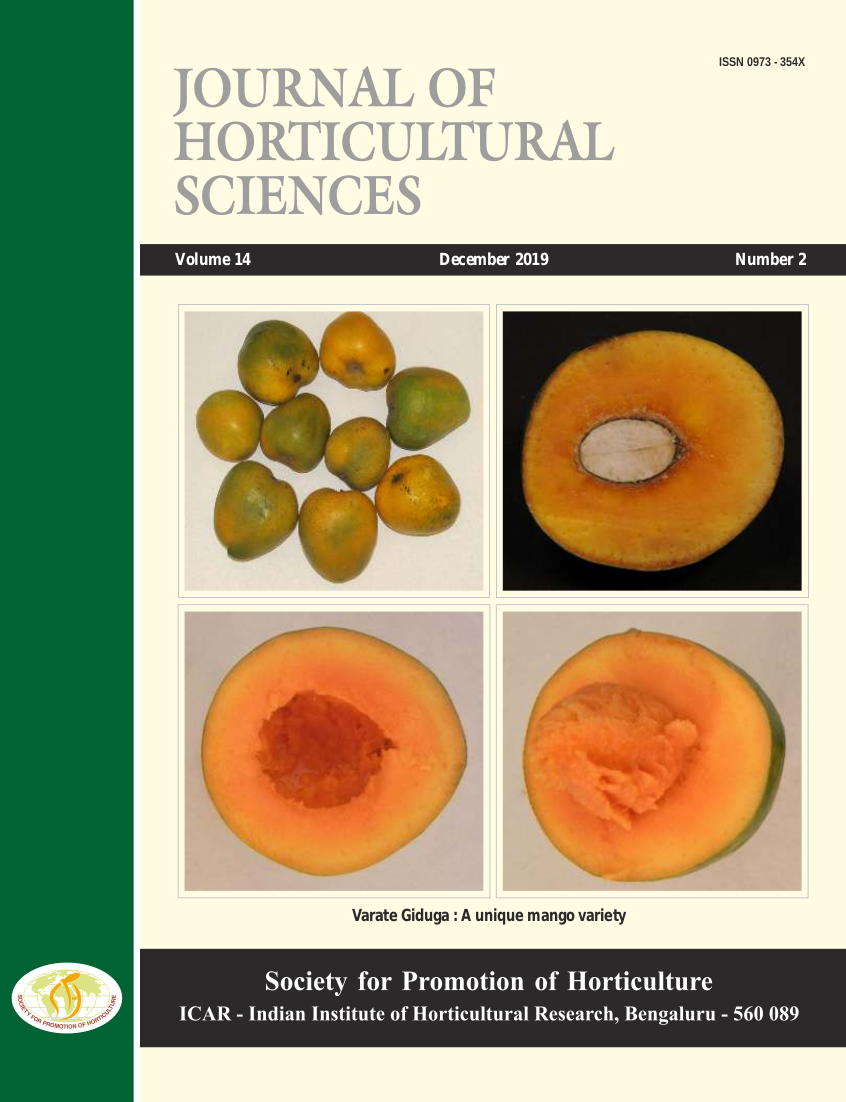Characterization of Rhizoctonia solani causing Fruit rot of Strawberry (Fragaria x ananassa Duch.) in Wayanad and in vitro Evaluation of Fungicides, Organic preparations and Bioagents for its Management
DOI:
https://doi.org/10.24154/jhs.v14i2.800Keywords:
Bioagents, Fungicides, Rhizoctonia solani, StrawberryAbstract
Strawberry, one of the most delicate, sweet and refreshing temperate fruit has grabbed the minds of several farmers and consumers all over the world. Several fungal diseases affect it. As part of the study, surveys were carried out in major strawberry growing parts of Kerala viz., Wayanad, Idukki, Malappuram and Thrissur. However, rotten fruits with dark and hard encrustations were collected only from Wayanad district during 2015-16. Pathogen was isolated by following the standard protocol and Koch’s postulates were proved. Upon culturing, the fungal isolate produced white mycelia turning brown on maturation with rapid growth. The hyphae were branched at right angles and did not produce spores. The pathogen was identified as Rhizoctonia solani based on cultural and morphological characters. In vitro evaluation was carried out with 9 fungicides and carbendazim 12% + mancozeb 63% , cymoxanil 8% + mancozeb 64% , propineb and Bordeaux mixture at all concentrations showed cent per cent inhibition. Copper hydroxide and difenoconazole inhibited the pathogen from 54.44 to 75 per cent and 58.88 to 70.55 per cent at 0.1, 0.15 and 0.2 and 0.05, 0.1 and 0.15, respectively. Copper oxychloride recorded less than 45 per cent inhibition, whereas carbendazim and potassium phosphonate were found to be least effective. Comparing the efficacy of organic preparations against Rhizoctonia, calphomil recorded highest inhibition of 55.33 to 63.88 per cent at different concentrations. Panchagavya and baking powder + vegetable oil mixture could inhibit the mycelial growth only by 23.33 to 25.50 per cent and 22.22 to 26 per cent, respectively. Whereas, neem oil was found to be least effective. Biocontrol agents were evaluated against the pathogen and Trichoderma asperellum could restrict growth of the pathogen by 66.67 per cent and Pseudomonas fluorescens by 33.33 per cent.
Downloads
References
Amin, F and Razdan, V. K. 2010. Potential of Trichoderma species as biocontrol agents of soil borne fungal propagules. J. Phytol. 2(10):38-41.
Ashlesha and Paul, Y.S. 2014. Antifungal bioefficacy of organic inputs against fungal pathogens of bell pepper. Indian J. Res. 3(6):4-6. DOI: https://doi.org/10.15373/22501991/June2014/2
De Los Santos, B., Barrau, C. and Romero, F. 2003. Strawberry fungal diseases.J. Food Agric. Environ.1:129-132.
Dennis, C. and Webster, J. 1971. Antagonistic properties of species-groups of Trichoderma: III. hyphal interaction.Trans. British Mycol. Soc.57(3):363-369. DOI: https://doi.org/10.1016/S0007-1536(71)80050-5
Dodge, B. O. and Stevens, N. E. 1924. The Rhizoctonia brown rot and other fruit rots of strawberries.J. Agric. Res.28(7):643-648.
Dogra, S. 2006. Antifungal potential of panchgavya against some soil borne pathogens. M.Sc. Thesis, Department of Plant Pathology, CSK Himachal Pradesh KrishiVishvavidyalaya, Palampur, India. pp.115.
Jandaik, S and Sharma V. 2016. Antifungal potential of panchagavya against soil borne fungal pathogens associated with capsicum nurseries. Int. Invention J. Agric. Soil Sci .4(2): 22-26.
Lal, M. and Kandhari, J. 2009. Cultural and morphological variability in Rhizoctonia solani isolates causing sheath blight of rice. J. Mycol. Plant Pathol. 39(1):77.
Mezeal, I. A. 2014. Study biocontrol efficacy of Pseudomonas fluorescens and Bacillus subtilis against Rhizoctonia solani and Fusarium oxysporum causing disease in tomato (Lycopersiconesculentum L.) Indian J. Fundam. Appl. Life Sci.4(4): 175-183.
Nechet, K. D. L. and Halfeld-Vieira, B. A. 2007. First report of Rhizoctonia solani causing web blight on pigeonpea in Brazil. Fitopatologia Brasileira, 32(4), 358-358. DOI: https://doi.org/10.1590/S0100-41582007000400013
Raj, Lal, A. A., Naik, T. S. and Shivakumar, K. V. 2016. Evaluation of fungicides against Rhizoctonia solani the causal agent of seedling rot of chilli.Advances in Life Sci.5(3):729-731.
Seema, M., Devaki, N. S. and Sreenivas, S. S. 2010. In vitro evaluation of fungicides against Rhizoctonia solani infecting FCV tobacco in Karnataka light soils.Pestology34(11):36-38.
Sharma, A. and Bhardwaj, L. N. 2001. Influence of temperature, relative humidity and nutrient solution on sporangial germination and zoospore liberation in Phytophthora cactorum causing leather rot of strawberry. Plant Dis. Res.
(2):243-246.
Sneh, B., Burpee, L. and Ogoshi, A. 1991. Identification of Rhizoctonia species. APS press. USA. pp. 133.
Seema, M and Devaki, N. S. 2012. In vitro evaluation of biological control agents against Rhizoctonia solani.J. Agric. Technol. 8(1):233-240.
Srinivas, P., Ratan, V., Patel, A. P. and Madhavi, G. B. 2013. Review on banded leaf and sheath blight of rice caused by Rhizoctonia solani Kuhn. International Journal of Applied Biology and Pharmaceutical Technology, 61(2): 80-97.
Tapwal, A., Thakur, G., Chandra, S. and Tyagi, A. 2015. In-vitro evaluation of Trichoderma species against seed borne pathogens.Int. J. Pharma Biosci.1(10), 14-19.
Timudo-Torrevilla, O. E., Everett, K. R., Waipara, N. W., Boyd-Wilson, K. S. H., Weeds, P., Langford, G. I. and Walter, M. 2005. Present status of strawberry fruit rot diseases in New Zealand.New Zealand Plant Prot.58:74-79. DOI: https://doi.org/10.30843/nzpp.2005.58.4257
Vincent, J. M. 1947. Distortion of fungal hyphae in the presence of certain inhibitors. Nature 159:850. DOI: https://doi.org/10.1038/159850b0
Downloads
Published
Issue
Section
License
Copyright (c) 2019 Amrutha P, Reshmy Vijayaraghavan (Author)

This work is licensed under a Creative Commons Attribution-NonCommercial-ShareAlike 4.0 International License.
Authors retain copyright. Articles published are made available as open access articles, distributed under the terms of the Creative Commons Attribution-NonCommercial-ShareAlike 4.0 International License, which permits unrestricted non-commercial use, distribution, and reproduction in any medium, provided the original author and source are credited. 
This journal permits and encourages authors to share their submitted versions (preprints), accepted versions (postprints) and/or published versions (publisher versions) freely under the CC BY-NC-SA 4.0 license while providing bibliographic details that credit, if applicable.





 .
. 











